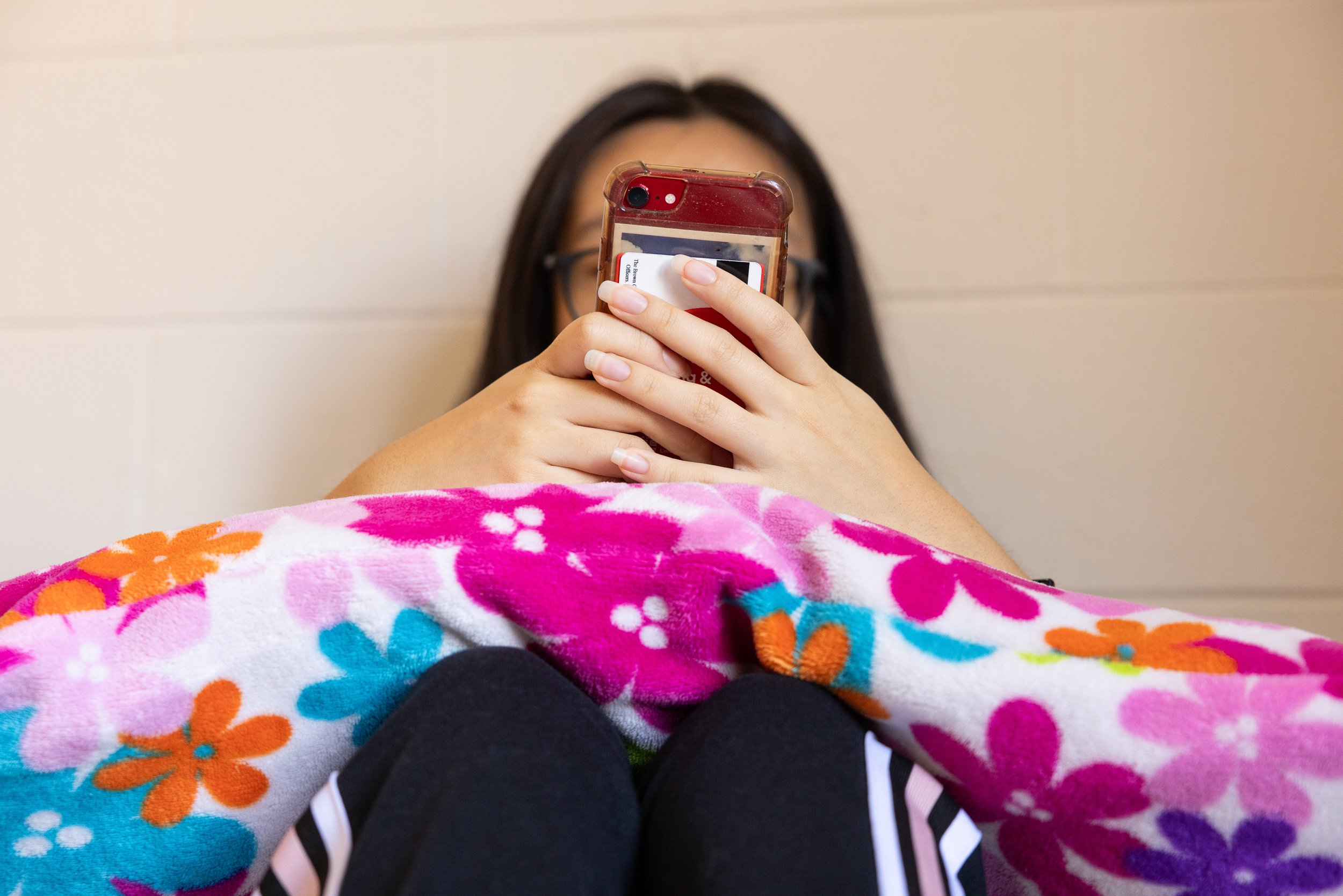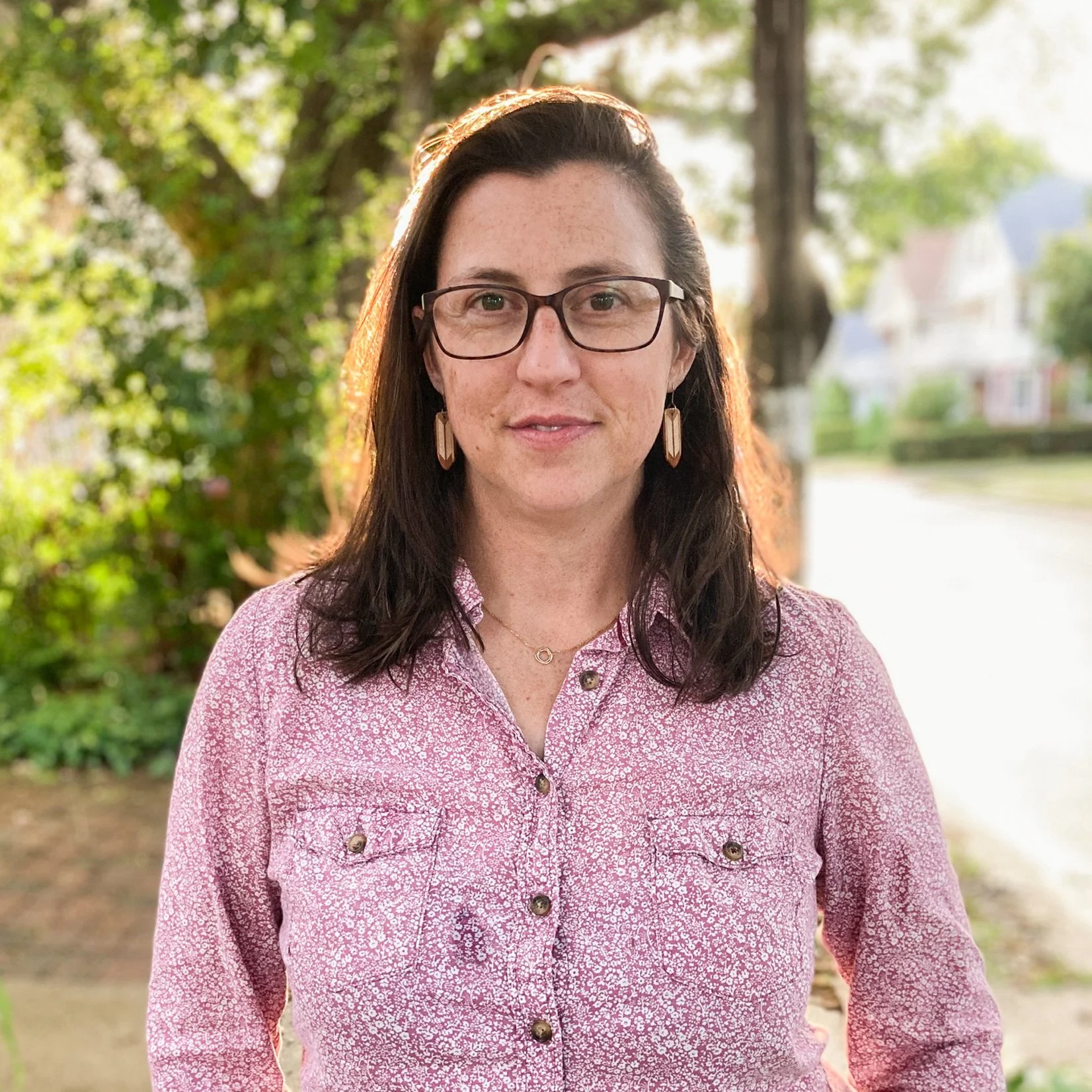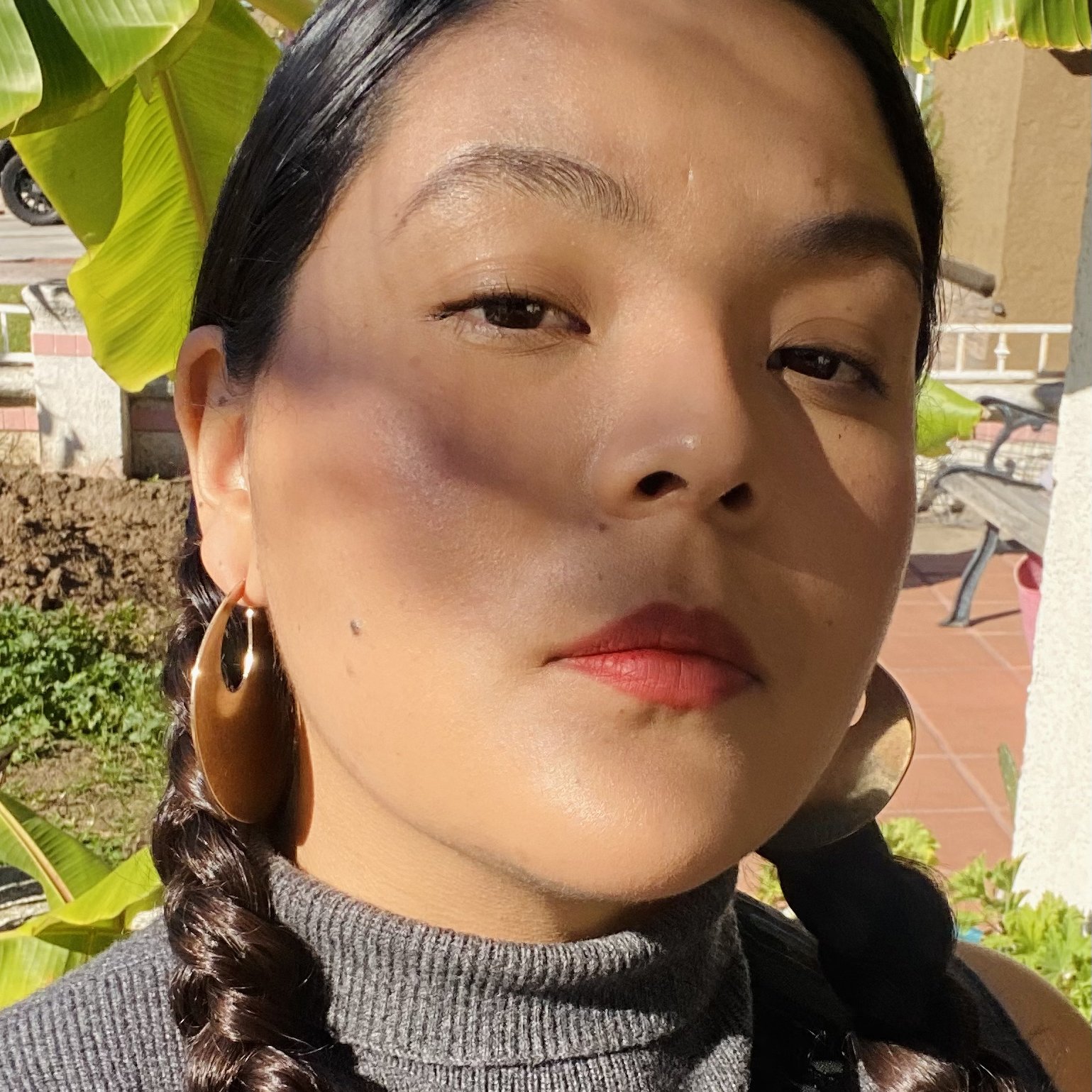For Latina Teens, a Mental Toll
Karen Mestizo peruses her phone in her dorm room at Brown University, where she is a first-year student. Photo by Josephine Sittenfeld for palabra
Teen girls across the U.S. are experiencing dramatic increases in depression and mental illness, but social media and the pandemic have compounded the challenges for Latinas and other girls of color. Culturally competent therapy, whole-child educational initiatives and community-based solutions can help
Haga clic aquí para leer el reportaje en español.
Karen Mestizo’s family appreciated the opportunity to spend more time together in their Stratford, Connecticut home as the COVID-19 pandemic surged in the spring of 2020. Her mom cooked big Mexican meals for a group of relatives who were in a “bubble” that included Mestizo’s dad, older sister, younger brother, an uncle and a family friend.
Within a few months, Mestizo, then in her first year of high school, gained a considerable amount of weight. She felt insecure about her body and struggled with time-consuming distance learning. Her school-issued Chromebook was so slow that she would wake at 6 a.m. to start homework, followed by virtual school. Often, she wouldn’t finish her work until midnight. The stress compounded after she discovered calorie counting on TikTok. Some days, she’d barely eat anything. Her family didn’t know how to support her effectively.
“What’s been hardest about the eating disorder is that my family doesn’t quite understand that it’s a mental problem. I feel actual guilt eating,” said Mestizo, now 18 and in her first year at Brown University.
Mestizo in her dorm room at Brown University. While she developed an eating disorder in high school, Mestizo finds it easier to eat regularly in the company of her new college friends than on her own. Photo by Josephine Sittenfeld for palabra
Then, her father, who worked in the food service industry, found himself out of work temporarily because of the pandemic. So in Mestizo’s sophomore year the family moved into a low-cost apartment in a church building with cracked windows and a shower that only produced scorching hot water. Mestizo and her siblings didn’t feel safe going outside; twice, intoxicated people urinated in the church parking lot and, on one occasion, a stranger came up to the apartment door while they were home alone. Mestizo slept poorly and woke as early as 3 a.m. to manage a demanding Advanced Placement course load. “That put me in a really stressful environment,” she recalled.
‘Being a teenager is a challenge. We’re in between being kids and being adults. We’re getting there. We’re learning how to do it.’
Mestizo isn’t alone. Teen girls across the country describe intense pressure to look and dress in certain ways, excel academically and in extracurriculars, and please everyone from their peers to their parents. While these stresses have always been part of adolescence, the Centers for Disease Control (CDC) found they reached a crisis point due to the isolation and trauma of COVID-19, in addition to always-on technology and the unforgiving court of social media. Many teen girls feel that they’ll be judged and criticized no matter what they do. They blame school cultures that fail to curb casual misogyny, homophobia, racism, harassment and bullying — and a mental health care system that’s difficult to navigate, lacks effective resources and can actually exacerbate a crisis through misdiagnosis or by separating teens from their support systems.
Mestizo takes a break from studying at Brown University to browse through her social media accounts. Photo by Josephine Sittenfeld for palabra
The challenges of adolescence are compounded for girls of color. Many Black, Brown and Indigenous girls feel an obligation to make their families proud, and to repay years of sacrifice by their parents and grandparents, who are often managing trauma themselves as a result of discrimination, harrowing immigration experiences and racism. Luzmary Hernandez, 18, of Silver Spring, Maryland, appreciates her mother’s decades of work to support the family after they immigrated from El Salvador a quarter century ago, first earning income as a housekeeper while Hernandez’s father remained in their home country for a time.
“When I have a career, hopefully I will be able to let my parents retire,” said Hernandez, who received a scholarship that allowed her to matriculate at the University of Maryland this fall. She and her siblings are the first generation in their family to attend college. “I owe it to her and my dad for all that they've done. They’ve climbed mountains for me.”
Girls of color also face barriers to care, including stigma around mental health treatment. On top of that, they may struggle to develop a strong identity that acknowledges the individualistic American culture they’ve grown up in and honors their families’ cultural roots. They and the experts who support them say solutions include school-based programs that address the needs of the whole child and train educators to support mental health, as well as a better pipeline of culturally informed, bilingual therapists who can effectively engage parents in supporting their children.
Mestizo in the Watson Institute for International and Public Affairs building at Brown University. Mestizo studies political science and has had a smooth transition to college. Photo by Josephine Sittenfeld for palabra
"There’s a lot of pressure on Hispanic girls,” said Elida Mejia Elias, 19, a recent high school graduate from Los Angeles.
Latinas face unique obstacles, Mejia Elias believes, from some overprotective parents who restrict their daughters’ social lives, to navigating the school system without the benefit of parental support because their parents didn’t go to school in the U.S. Add to that the general difficulties of adolescence. "Being a teenager is a challenge. We’re in between being kids and being adults. We’re getting there. We’re learning how to do it," she said.
‘I want the caregivers in these adolescents’ lives to take a good look at the mirror. If you have an anxious teen, if you have a depressed teen, what’s going on for you and how are you being that secure base?’
Data supports Mestizo’s and Mejia Elias’s experiences: Earlier this year, the CDC found that, 30% of high school girls reported seriously considering suicide and 14% were forced to have sex in 2021, up two percentage points in two years. Fifty-seven percent of teenage girls felt so persistently hopeless or sad over the prior two weeks that they stopped regular activities — double the number of boys who felt similarly.
“We’re in year four of the pandemic with everybody having an aspect of burnout. The adults at school have been as stressed as the adults at home,” noted Lina Acosta Sandaal, a psychotherapist and owner of Stop Parenting Alone, a parent education consultancy based in Miami. “I want the caregivers in these adolescents’ lives to take a good look at the mirror. If you have an anxious teen, if you have a depressed teen, what’s going on for you and how are you being that secure base?”
Mestizo braids her hair in her dorm. Photo by Josephine Sittenfeld for palabra
A note above Mestizo’s bed referencing an incident in which she helped a schoolmate who was struggling. Photo by Josephine Sittenfeld for palabra
Constant scrutiny and pressure
At the Bronx High School of Science in New York City, recent graduate Najiha Uddin sees girls repeatedly silenced in class and the hallways, their perspectives ignored, being drowned out by boys, and judged for their interests, appearance and beliefs. “Girls have been picked apart from almost the minute that they're born,” Uddin, 18, said, describing teasing or name calling as “plain misogyny.” “Even when I know the right answer (to an academic question), a lot of the time, I’ll be over-explained and questioned about how I derived my answer. Sometimes it sort of leads me to question if I'm correct.”
Girls across the country describe teen cultures of casual slut-shaming, of peers greeting girls with sexist slurs, based on what they wear or how they look. “Girls are expected to laugh and just play along with the joke,” Uddin said.
Social media amplifies insecurity about their appearance, with some TikTok videos critiquing girls’ body shape, like the normal curve of their stomach. “What we’re told to be insecure about is something that’s so natural,” Uddin added.
‘Hispanics always try to shake off things because we’ve got to be strong.’
Mejia Elias elaborated on the problem, saying that sometimes boys manipulate and exploit girls, without any consequences. She said they pass around nudes and critique girls’ bodies, finding fault no matter what they look like.
Being held to a white beauty standard can be especially painful for girls of color. “Imagine the pressures that girls have to carry, with the influx of images that define and actually limit the standards of beauty, based on what our young girls see on social media and television,” said Dena Nicole Simmons, founder and executive director of LiberatED, an organization that centers radical love, healing, and social and racial justice in education and social emotional learning.
Daniella Muñoz contemplates her outfit in the mirror at home in Apopka, Florida, where she’s a senior in high school. Surrounding the mirror are photos of people she holds dear. Photo by Michelle Bruzzese for palabra
The white beauty ideal is all too real for many Latina girls, including Daniella Muñoz, now 18, who felt that the thin girls at her majority white middle school in Central Florida judged her because of her curvier frame. “You see all the other girls; they’re stick figures,” said Muñoz, a first-generation American whose parents immigrated from Ecuador to Orlando. “On social media platforms, all the influencers and models have this skinny body. You don’t see a lot of people with my body.”
Muñoz’s mother saw her sink into depression and become consumed with anxiety, and sought help for her daughter. Counseling helped Muñoz out of the depths of despair. She has enjoyed a more diverse experience at PSI High in Sanford, Florida, where she is now a senior. “Hispanics always try to shake off things because we’ve got to be strong,” she said. “Now I take it one day at a time, and always (try to) be my authentic self.”
Between cultures — and COVID-19
All this scrutiny happens at a time when girls’ bodies are developing and they’re figuring out who they want to be as young adults. But COVID-19 complicated normal adolescent development as teens navigated those normal body and brain changes alone in their rooms during an abnormal circumstance: pandemic lockdowns. Isolation eroded social skills and quarantines and distance learning kept many teens sedentary.
Leilah Villegas at home in Eastvale, California. Villegas, a runner, lost confidence in herself during the pandemic, both in track and socially. Photo by Julie Leopo-Bermudez for palabra
Leilah Villegas of Eastvale, California ran track and led a very active life in middle school. But during the pandemic, she felt no motivation to work out. In 10th grade, she started running again, but often felt discouraged because she was slower than her teammates or felt self-conscious about her body. “When I run and don’t feel like I can catch up with everyone, I feel really bad. Every time that happens to me I say I want to quit,” she said. “I wonder if the people in front of me are thinking about how slow I am. If I were doing this before COVID, this would be so easy for me.”
‘When in-person school resumed, routine encounters and moments felt weird for many students after a year or more of separation from peers.’
Returning to “normal” after the worst of the pandemic had passed was also fraught. Figuring out how to interact with peers after lockdown ended presented new challenges, and many teens lacked the skills and tools to meet that moment. When in-person school resumed, routine encounters and moments felt weird for many students who had been separated from peers for a year or more. Social cues and norms had changed, introducing even more uncertainty about how to act, as well as how to interpret the behavior of others.
“It felt wrong to take off my mask to eat during lunch. I didn’t know if I should pull my mask down and eat and then put it up,” explained Villegas, now 17 years old. “It’s a lot of small things. Say you’re walking in the hallways… to get to the next class and you see someone. You’re not friends, but you’re classmates. I’ll overthink, ‘Should I wave to them or do I keep walking?’”
Villegas gets ready to work out in her family’s home gym. Her mom is a personal trainer. Photo by Julie Leopo-Bermudez for palabra
Reyna, an 18-year-old first-year college student in Santa Ana, California, who asked not to be identified by her full name in order to discuss a sensitive topic, sometimes feels more comfortable with a mask on because she doesn’t want to be accused of “mask fishing,” which means to appear better looking with the mask on but revealing a “funky nose or wider lips” when it’s taken off. “Hiding under a mask was a way for me to feel more comfortable. It wasn’t safety from COVID; it was more of a safety so people can’t see how ugly I perceive myself,” she said.
When Reyna was depressed in 10th grade, her mother sought therapy but told her to keep it a secret because of the stigma in their Mexican culture. Even her stepfather didn’t know during the first semester.
Reyna isn’t an outlier; many teens with depression or anxiety are also navigating a bicultural identity, having grown up with American culture in school and Latino immigrant culture at home, said Goldie Barajas, who recently received a PsyD from Alliant International University. Mexican and many Central American cultures frown upon expressing emotions and negative feelings, thinking that dwelling on an issue will make it worse. “If you’re feeling depressed, parents think that means you need to be more occupied. You need to clean or find a new hobby. They tend to jump into problem solving right away,” Barajas said. “It comes from a place of love. It’s coming from parents not having the ability to sit with their emotions and discomfort in seeing their children suffering.”
Villegas in front of her childhood portraits in the hallway of her Eastvale home. Photo by Julie Leopo-Bermudez for palabra
Reyna learned coping skills with the help of her therapist: writing down goals, reflecting on life, and paying attention to basic needs, like staying hydrated and getting regular exercise. Therapists can also help entire family units, especially through functional family therapy, which works with a family’s cultural values to identify the parents’ intentions and underlying beliefs, so that children can get help without rejecting their roots or blaming their parents.
‘Supporting Latina youth and adolescent girls in general means having access to jobs, housing, health care, education that is equitable and speaks to the experience of that youth.’
“Trauma is pervasive in our society right now,” said Mercedes Martinez, a psychiatrist based in Chicago, citing a broken mental health care system, financial stress, racism and anti-immigration sentiment as factors that contribute to teen depression, anxiety, and suicidality. “In a country that has more than 1,500 anti-immigration laws and anti-immigration rhetoric, that can be very daunting for a Latina.”
Leslie Priscilla, founder of Latinx Parenting in Santa Ana, adds that broader social problems exert pressure on families and compound stress on young people. “Supporting Latina youth and adolescent girls in general means having access to jobs, housing, health care, education that is equitable and speaks to the experience of that youth,” she said. “Those are very concrete things and that’s what we have to work for, not just the individual.”
Muñoz studies in the kitchen of her parents' home in Florida. Photo by Michelle Bruzzese for palabra
School — and community— based solutions
The most urgent needs to address the teen mental health crisis are culturally competent therapists and counselors, ideally bilingual, and the normalization of therapy, Martinez said. In this context, cultural competence means, among other things, that mental health professionals recognize when parents’ involvement in the lives of their young adult children isn’t necessarily problematic enmeshment, but rather a reflection of cultural values. The goal is for Latina teens to incorporate the strengths of both cultures into their identities rather than having to reject one, she said.
The survival skills that enable parents to come to the U.S. and find success sometimes cause relationship ruptures with their children, said Lizett Gutierrez, a South Amerindian bilingual therapist based in Denver. “More and more families are open to the idea of allowing someone to talk with them about their struggles and also validate their perspective, their stories, (and teach them) emotion-focused language, which can be new and can be jarring,” Gutierrez said. “Change can be scary across the board for a lot of folks.”
A Houston-based program called FuelEd trains K-12 educators to increase their emotional intelligence, build skills to support the whole child, and improve relationships with students, families, and other teachers. Trainers emphasize building skills of empathy, communication, and genuineness so that educators can deliver mental health support and strengthen students’ resilience, said Damanique Williams, a trainer with FuelEd, which supports educators across the country. There is evidence that schools with stronger teacher-student relationships experience less bullying, less drop out, more conflict resolution skills, better mental health, and adults who have more job satisfaction. Students’ test scores and attendance also improve.
Muñoz in her bedroom. Photo by Michelle Bruzzese for palabra
“If a kid has at least one adult in their life who’s really invested in making sure they are seen and heard, they’re tremendously resilient no matter what’s happening in their home, no matter the collective trauma,” Williams said. “You don’t have to be a trauma therapist; you can just show up for the students.”
Teachers can reach students and deliver support in ways that therapists can’t, she noted, especially when families are resistant to counseling. “As a therapist, I can’t talk to kids without consent, but if the history teacher decides she wants to start a group, she can utilize those same skills and parents are receptive to that. She’s able to enter spaces that the mental health counselors aren’t able to enter,” she said.
Efforts are also needed beyond school. As a program of Denver’s WellPower community mental health agency, the group Voz y Corazón uses creative expression to build self-awareness and community, as Latino youth who have struggled with mental illness express themselves through art. The goal is to de-stigmatize mental illness, including suicidal thoughts and ideation.
To overcome the stigma associated with seeking mental health support and build trust in the community, some programs train and work through promotoras, trusted individuals who recognize and can respond to community members’ needs that impact mental health. Promotoras share information about food banks, enrichment programs and health care, for example. “The more that folks hear and see (mental health support) is really in their community, they will start to have less fear around registering or showing up,” Gutierrez said.
Muñoz toys with her “self-love” bracelet, a gift from her mother. Photo by Michelle Bruzzese for palabra
What also helps is looking out for one another. Garvey Mortley, a 14-year old in Bethesda, noticed one friend growing quieter and more isolated. Despite Mortley’s outreach, the girl wouldn’t open up, until one day she expressed feeling suicidal. Mortley encouraged her to find a help line or tell her parents. “It’s hard to navigate when you don’t have communication,” she said.
Affirming mental health care for children of all races and ethnicities will help stem the crisis, Simmons said. “I can’t tell you how often I’ve gone to a white therapist and they’ve made me the problem and not the system,” she shared. “We need to diversify the mental health field, increase access to quality mental health resources, and de-stigmatize mental health care.”
All the girls interviewed for this story said they asked adults to listen to and believe girls, to stop dismissing their concerns as drama, and to provide resources that actually support them — at school and beyond.
Mortley believes “school is also a big contributor to depression, especially in students who want to overachieve.” It’s hard to get good grades,” she said. “It takes a toll on you.”
A combination of youth, family, school and community solutions has the potential to support teen girls’ mental health and ensure the next generation can thrive. “We can’t send out a legion of therapists, but we can create programs that make a difference for a lot of children,” Williams said.
—
Katherine Reynolds Lewis is an award-winning science journalist covering children, behavioral and mental health, education, race, gender, disability, and related topics for The Atlantic, the New York Times, Undark, and The Washington Post, among other publications. Her book “The Good News About Bad Behavior” grew out of Mother Jones’ most-read story. A Harvard physics graduate, Katherine is the founder of the Institute for Independent Journalists and a former national correspondent for Newhouse and Bloomberg News.
Josephine Sittenfeld is a photographer and filmmaker based in Providence, R.I. Her work has been published in The New Yorker, The New York Times, Aeon Magazine, and Shondaland. Her coming-of-age documentary about a young man with autism filmed over a twelve-year span, Growing Up Ethan, is part of the Smithsonian National Portrait Gallery “The Outwin 2022: American Portraiture Today” traveling exhibition, currently showing at the Ackland Art Museum, UNC Chapel Hill.
Julie Leopo is a California-based award-winning photojournalist who explores culture, politics, identity, and social issues and has a passion for amplifying the stories of bicultural and bilingual communities through her photography. In 2021, Latino Journalists of California, CCNMA named Julie one of “California’s Most Influential Latina Journalists,” and in 2022 she was a runner-up for the prestigious Ruben Salazar Journalism Award for her reporting on the Oxnard beach community.
Michelle Bruzzese (she/her) is a photographer specializing in portraits and human-interest stories. Her work has been featured in numerous publications including People Magazine, Time Magazine, Bloomberg, NPR the FT Weekend and others. She is a 1st generation American; her parents immigrated from Italy and Ecuador. She graduated from Parsons School of Design in NYC with a BFA in photography and is currently based in Central Florida. Find her work at michellebruzzese.com
Julie Schwietert Collazo is a bilingual writer, editor, fact-checker, and translator, as well as the co-founder and director of Immigrant Families Together, a nonprofit formed in 2018 to respond to the family separation policy. Along with Rosayra Pablo Cruz, she wrote “The Book of Rosy/El libro de Rosy,” published by HarperOne and HarperCollins Español in 2020. Both authors are featured in the documentary “Split at the Root/Dividida en la Raíz,” which is streaming on Netflix.






















